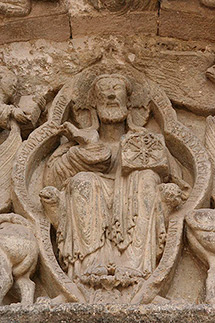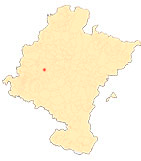La Portada de San Miguel de Estella
registration of the mandorla
One of the most interesting elements of the cover is the registration that runs around the quadrilobular mandorla around the figure of Christ in majesty. The Latin text reads NEC DEUS EST NEC HOMO PRESENS QUAM CERNIS IMAGO SED DEUS EST ET HOMO QUEM SACRA FIGURAT IMAGO, which could be translated: "Neither God nor man is the present image you discern, but God and man is he whom the sacred image represents".
This is a text of profound religious significance, which may be intended for two reasons. The repetition of the word IMAGO could insist that what the viewer sees is an image (in this case a stone image) and not the divinity itself. In this sense, the text would bring to report the controversy over the use of images that was so important in Byzantium during the 8th and 9th centuries. One might wonder whether the iconoclastic tendencies of certain heresies in the West, and specifically the Catharism spread on the other side of the Pyrenees, might have reached Estella, where there is evidence of Occitan presence in the 12th century.
On the other hand, two other words, DEUS and HOMO, are duplicated, indicating an interest in preaching one of the fundamental dogmas of orthodox Christian beliefs: the Incarnation of the Son of God, which made Jesus Christ true God and true man. The dual nature of Christ was not a truth accepted without question throughout the West. On the contrary, there were still heretics who did not admit it, among them the Cathars and the Petrobrussians who spread in the south of France.
The topic was of interest to Navarrese clerics in the second half of the 12th century: Pedro de París, also known as Pedro de Artajona, bishop of Pamplona between 1167 and 1193, in the years when this cover was supposedly made, wrote a theological treatise on the Trinity and the Incarnation that is preserved at the Library Services of the University of Salamanca.
The epigrapher Robert Favreau noted the almost total identity between the verses from Estella and a text by Abbot Baudri de Bourgueil (†1130), one of the manuscripts of which is directed "against the Jews, the heretics and the Saracens who say that we [Christians] worship idols". It is unlikely that the tympanum was designed to convince the Jews of Stella, who lived on the other side of the river, but rather to show the Christians of the neighbourhood and the visitors to the market certain fundamental contents of Christian dogma.











